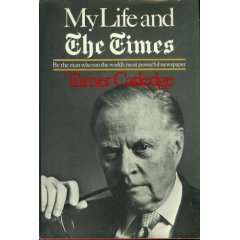Major Works
- My Life and The Times
Biography of Turner Catledge
Turner Catledge was born in 1901 on his grandfather’s farm near New Prospect, Mississippi. His family moved to Philadelphia, Mississippi, when Turner was three. There he lived with his parents, Lee and Willie Catledge, and his sister Bessie.
At the age of 14, he set type for the Neshoba Democrat. Catledge wanted to attend college at Ole Miss in Oxford, but he couldn’t afford it. Instead, he chose to attend Mississippi A&M, also known as Mississippi State University. While in college, Catledge worked in the mess hall. He later learned the skill of touch-system typing, and he got a job as a secretary to Fitzjohn Wadell. Wadell was able to get Catledge a job as an assistant to the school’s agricultural editor.
His senior year, he was elected as the editor of the college yearbook. Catledge graduated from Mississippi A&M with honors and with an average above 85. After college, Turner was ready to get out on his own, but he wasn’t sure where to begin.
It was then that Clayton Rand, the publisher of the Neshoba Democrat, offered Catledge a job. In 1922, Catledge became editor of the Tunica Times and then managing editor and mechanical superintendent of the Tupelo Journal, where he campaigned against the Ku Klux Klan.
He moved to Memphis, Tennessee, where he worked for the Commercial Appeal. In the spring of 1929, Catledge began working for the New York Times. Catledge joined the paper’s Washington bureau and worked in the House of Representatives.
On March 19, 1931, Turner Catledge and Mildred Turner were married at the Church of the Transfiguration in New York. Mildred and Turner had two daughters together, Mildred Lee, who was born in 1932, and Ellen Douglas, who was born in 1936.
In 1949, Turner and Mildred were legally separated and divorced later. Years later, Catledge met Abby Ray Izard, a widow from New Orleans, and they were married in December 1957.
Catledge continued working for the New York Times until he retired in January 1970. He became the managing editor and then the executive editor. When Catledge retired, he was the vice president of the Times.
Catledge died in 1983 at the age of eighty-two. A memorial service for Turner Catledge was held June 28 at 11 A.M. in the Grace Rainey Rogers Auditorium of the Metropolitan Museum of Art. Mr. Catledge died on April 27 at his home in New Orleans, where he had lived since his retirement from The Times in 1970.
The Special Collections Department of Mississippi State University Library has a collection of the personal and business papers of Turner Catledge dating from 1873 to 1985. According to the Mitchell Memorial Library web site: “During his career, Catledge served the Times as Capitol correspondent, White House correspondent, chief news correspondent, national correspondent managing editor, executive managing editor, vice-president, and board member until his retirement in 1973.
Catledge also worked for the Chicago Sun as roving correspondent and editor-in-chief from 1941-1943. In 1957, Catledge interviewed Nikita Khrushchev, and achieved exclusive coverage of Khrushchev’s call for a summit meeting of world leaders.”
Timeline
- 1901- Turner Catledge was born in New Prospect, Mississippi
- 1922- Turner graduates from Mississippi A&M
- 1929- Turner begins working for the New York Times
- 1931- Turner and Mildred are married
- 1932- Mildred Lee, Turner and Mildred’s daughter is born
- 1936- Ellen Douglas is born
- 1949- Mildred and Turner are divorced
- 1957- Turner and Abby Ray Izard are married
- 1970- Turner retires from the New York Times
- 1983- Turner dies at age 82
Reviews
Book Review of My Life and The Times
by Laurie Montgomery, SHS
My Life and The Times is an autobiography by Turner Catledge. He tells his entire story from the time he was a youth in Mississippi until his retirement from the New York Times. He started working at Mississippi A&M (now Mississippi State University) in the mess room. After he graduated, he got jobs working for several newspapers. Catledge worked for the Commercial Appeal and the Baltimore Sun to name a few.
When Herbert Hoover was President, Coolidge’s Secretary of Commerce wrote a letter of recommendation for Catledge to Adolf Ochs, the publisher of the New York Times. Ochs gave the letter to his acting managing editor, who put the letter in his desk drawer. After Hoover became president, he called Ochs, asking him why he had not hired Catledge. Two years after the letter was written, Catledge got a job working for the New York Times.
In the book, Turner Catledge went into great detail about his entire life. The story was rather slow at first, but it got interesting after a while. It seemed that Catledge never applied for any of the newspaper jobs that he received throughout his life. Catledge was a hard worker, and he liked people. He never complained about anything that he did because he was ambitious and he loved the “newspaper game.”
Bibliography
- Catledge, Turner. My Life and The Times. Evanston, NY: Harper and Rowe, 1971.

